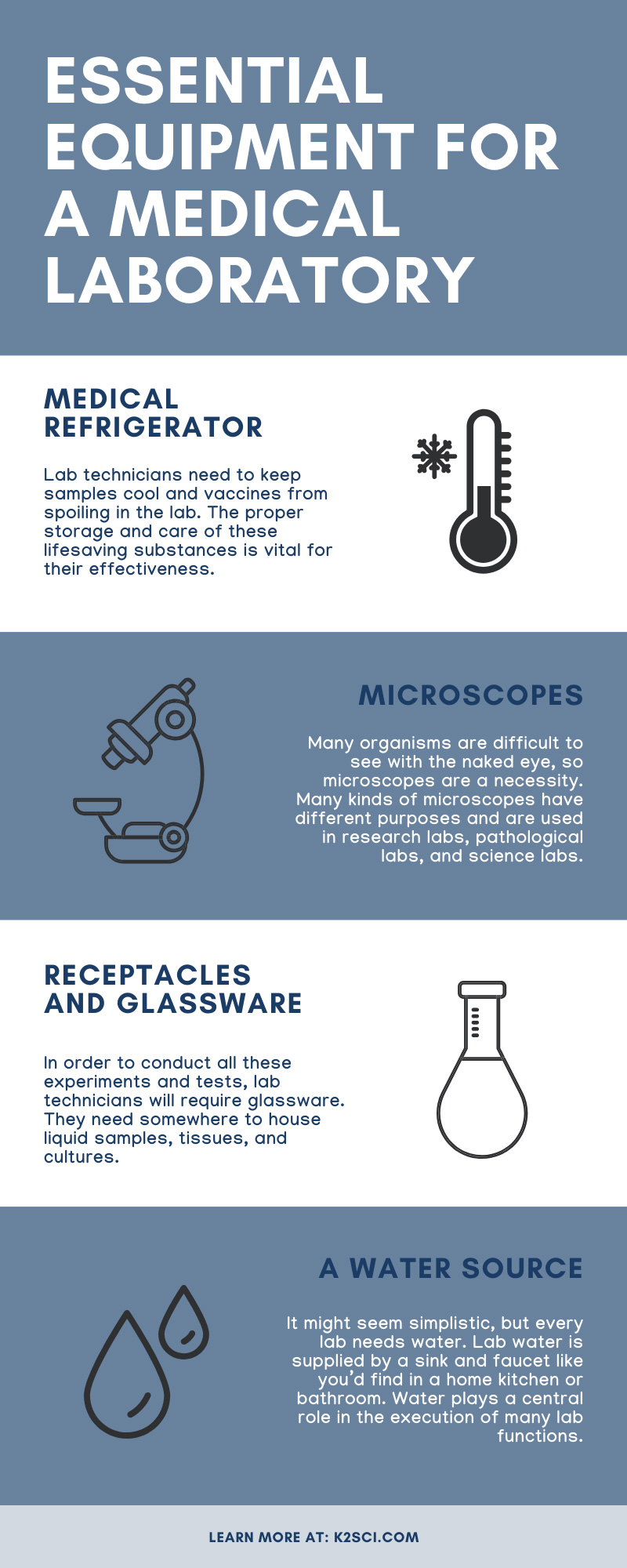Every year there are hundreds of new and improved medical devices released into the world. The latest and greatest products are available to researchers and lab technicians all the time, making it hard to know what’s useful and what’s junk. High-tech everything invades the space, confusing buyers and medical professionals alike. Some tried-and-true pieces of equipment will always be needed and useful in the laboratory setting. A handful of crucial items make up the backbone of any good lab and the important work done in them. We have listed some essential equipment for a medical laboratory. Get familiar with this equipment and ignore all the shiny new stuff that’s little more than a new coat of paint on the same old tech.
Medical Refrigerator
Lab technicians need to keep samples cool and vaccines from spoiling in the lab. The proper storage and care of these lifesaving substances is vital for their effectiveness. Vaccines that are not stored at the proper temperatures risk spoiling. There are living organisms within the vaccine that will degrade if not refrigerated. Laboratories need refrigeration to maintain a consistent temperature to mitigate the risk of bacterial contamination. The refrigerators need to have separate compartments to avoid cross-contamination with samples. Strict regulations and guidelines for the proper storage of everything within the lab are necessary for the longevity and security of the various stored samples.
Microscopes
One of the first things children learn when introduced to science at school is how to use a microscope and what kind of capabilities it possesses. Many organisms are difficult to see with the naked eye, so microscopes are a necessity. Many kinds of microscopes have different purposes and are used in research labs, pathological labs, and science labs. Lab technicians use the microscope to better see samples and examine them in greater detail for diagnostic reasons and research. Microscopes range from simple devices used in a classroom setting or for personal use to compound light microscopes used in biological applications.
Autoclaves
The autoclave is as common in the laboratory setting as the microscope, with a similar number of functions. An autoclave is a pressure chamber that sterilizes glassware, instruments, tools, waste, and media. They are necessary to avoid contamination in the experiments and to ensure the safety of all the people working in the lab. An autoclave is critical for eliminating infectious materials in the lab. Before contaminated items like Petri dishes, pipettes, or gloves can leave the lab they must be sterilized. Sending infectious materials out into the world is a fast way to spread disease so they cannot go to the garbage dump before they go into an autoclave.
Hotplates
Hotplates in a laboratory aren’t there to heat lunch, but they use the same technology. A hotplate is a hotplate, and it’s exactly what you’re thinking of, only the use is different in the laboratory setting than in the lunchroom. The hot plate is a vital device in the lab for heating samples. The major advantage of the hot plate is that it can heat samples without using a spark or open flame. In some labs, there are very volatile chemicals and gases that, if combined with a spark, could explode. Many of them come with digital displays so the technician can monitor the temperatures and control them better.
A Water Source
It might seem simplistic, but every lab needs water. Lab water is supplied by a sink and faucet like you’d find in a home kitchen or bathroom. Water plays a central role in the execution of many lab functions. Water is needed to freeze, wash, and dilute. Along with the water source comes purifiers attached to the sink to remove any impurities in the water. Water baths and incubators are important tools in the lab setting, and water is important for promoting the desired chemical reactions. Water is also needed for sanitation and the cleaning of tools, tables, and instruments in the lab. Cleanliness in the lab is important to reduce the risks of cross-contamination and the spread of bacteria and germs to the scientists working there.
Receptacles and Glassware
To conduct all these experiments and tests, lab technicians will require glassware. They need somewhere to house liquid samples, tissues, and cultures. Test tubes, petri dishes, beakers, and flasks are some of the receptacles that you’ll find in the lab. Without them, not much work would get done in the lab. Scientists must keep their samples identified and organized so they don’t mix them up or contaminate them. It is easy to write on glass dishes and tubes or apply labels to them. Misidentifying something in a lab could lead to a catastrophic accident or death.
Incubators
Laboratory incubators are a controlled, contaminant-free environment for safe work with cell and tissue cultures. They regulate conditions like humidity, temperature, and CO2 and allow the lab techs to control and adjust the environment as needed. One example is a microbiological incubator, which is used to grow and store bacteria cultures. The main purpose of incubators is contamination control and reduce the potential of it. Bacteria cultures need a specific environment to grow, so certain temperatures and humidity levels must be kept consistent to grow and maintain the cultures for further experimentation.
Personal Protective Equipment
The lab can be a dangerous place, depending on the kind of work and substances involved in a given experiment. The risks and dangers run far beyond normal workplace dangers like carpal tunnel syndrome or using caution around machinery. Lab technicians can contract infectious, fatal diseases if they aren’t careful about what they are doing and how they handle things. Personal protective equipment (PPE) must always be used in a lab, as it might be the difference between life and death. Many kinds of PPE are available, depending on the function of the lab is. Respiratory protection, face masks, gloves, safety glasses, lab coats, and emergency eye wash stations are just a few of the things you’ll find.

